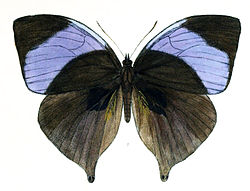Description
The male's upperside is brownish black with white cilia. There is a broad pale blue discal band extending from costa to near apex of vein 1. Hindwing uniform without markings. Underside pinkish buff, with the following dark brown lines crossing both forewing and hindwing: basal, extending to little beyond the middle of vein 2 in the hindwing, subbasal crossing from subcostal of the forewing to median vein of hindwing, discal from costa of the forewing to near tornus of hindwing, postdiscal from costa of the forewing to tornus of hindwing, thence bending upwards at an angle and following the dorsal margin of hindwing, and subterminal somewhat indistinct on the forewing, well defined and broadening towards tornus of hindwing. In addition to these there are on the forewing a short line of the same colour crossing the cell near apex and a discal line from costa to vein 2, and on the hindwing a large ochraceous postdiscal ocellus in interspace 2 and another in interspace 6. Antennae brown; head, thorax and abdomen dark brown. Sex-marks a patch of specialized scales in cell, extending into interspaces 1 and 2, and a glandular fold near base of vein with a stifle brush of hairs beneath it.
Female has the upperside umber brown. Forewing with a band as in the male, but bright yellow, narrower, reaching to the tornus, its inner margin very irregularly zigzag and sinuous, a spot below it in the middle. Hindwing uniform, apex bright yellow. Underside as in the male, but the ground colour paler. [3]
This page is based on this
Wikipedia article Text is available under the
CC BY-SA 4.0 license; additional terms may apply.
Images, videos and audio are available under their respective licenses.



